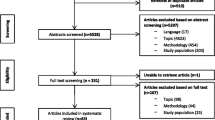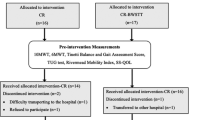Abstract
The high prevalence of 'bedridden elderly' in Japan is at least three times higher than that of any other industrialized country. To decrease likelihood of being bedridden, it is important to cultivate and maintain the willingness of older disabled patients for rehabilitation, and to preserve functioning in activities of daily living (ADL). The purpose of this study was to identify the factors facilitating and inhibiting the willingness of institutionalized disabled older adults for rehabilitation with respect to physical, goal-attainment, psychological and cultural aspects. The convenience sample consisted of 71 disabled older adults (45 in Japan and 26 in the USA). 46 subjects (64.8%) were identified as 'willing for rehabilitation', whereas 25 (35.2%) were 'unwilling for rehabilitation'. The data were gathered using structured interviews to subjects and administering questionnaires to the nurses. The data were compared between the 'willing' and the 'unwilling', and between those from Japan and from the USA by cross-tabular and correlational analyses. The major findings in this study were as follows: (1) Factors found to facilitate willingness of older persons for rehabilitation included: high independence level in ADL, generalized endurance/stamina, lack of pain, mutual goal agreement between old people and care staff, and no presence of regressive behavior. (2) Factors found to inhibit willingness of older persons for rehabilitation included: lower independence in ADL, presence of pain, generalized little stamina, depression, presence of regressive behavior, and dementia, and expectation of another person's help all the time. Healthcare workers need to be aware of patients who are subject to factors inhibiting willingness, and to promote factors facilitating willingness, in order to prevent the elderly with disabilities from becoming bedridden. In addition, the implications of this study are for a multidimensional functional assessment to be part of the rehabilitation intake in order to better understand each individual and motivate his/her optimum level of functional ability.
Similar content being viewed by others
References
Baltes, M. M. & Werner-Wahl, H. (1983). Dependence in aging. In L. L. Carstensen & B. A. Edelstein (eds.), Handbook of clinical gerontology (pp. 204–221). New York: Van Nostrand Reinhold Co.
Blocker, W. P. (1992). Maintaining functioning independence by mobilizing the aged, Geriatrics 47(1): 42–56.
Corcoran, P. J. (1991). Use it or lose it: The hazards of bed rest and inactivity, Western Journal of Medicine 154(5): 536–538.
Coy, J. A. (1989). Autonomy-based informed consent: Ethical implications for patient noncompliance, Physical Therapy 69(10): 826–833.
Doi, T. (1973). The anatomy of dependency. Tokyo: Kodansha International.
Ebersole, P. & Hess, P. (1994). Toward healthy aging: Human needs and nursing response. St Louis: The CV Mosby Co.
Erdman, W. J. (1975). The outlook for the stroke patient. In S. Licht (ed.), Stroke and its rehabilitation. Baltimore: Waverly Press.
Feigenson, J. S., McCarthy, M. L., Greenberg, S. D. & Feigenson, W. D. (1977). Factors influencing outcome and length of stay in a stroke rehabilitiation unit, Stroke 8(6): 657–662.
Granger, C. V., Dewis, L. S., Peters, N. C., Sherwood, C. C. & Barrett, J. E. (1979). Stroke rehabilitation: Analysis of repeated Barthel Index measures, Archives of Physical Medicine and Rehabilitation 60: 14–17.
Health & Welfare Statistics Association (1996, 1997). Kokumin eisei no doukou [Trends in public health in Japan]. Tokyo: Author.
Hirschberg, G. G. (1976). Ambulation and self-care are goals of rehabilitiation after stroke, Geriatrics 31(5): 61–65.
Imai, Y. (1990). Americajin to nihonjin: Kyokasho ga kataru tsuyoi kojin to yasashii ichiin [American and Japanese]. Tokyo: Souryu Shuppan.
Jaceron, C. S. (1986). The Barthel Index and other indices of functional ability, Rehabilitation Nursing 11(4): 9–11.
Jinushi, S. (1987). Economic analysis of medical care for the aged. In Mori & Homma (eds.), Medical science and health care in the coming century: a report from Japan (pp. 83–87). New York: Elsevier.
King, I. (1981). A theory for nursing: Systems, concepts, process. New York: Wiley Medical Publications.
Lebra, T. S. (1976). Dependency. In T. S. Lebra (ed.), Japanese patterns of behavior (pp. 56–66). Honolulu: University Press of Hawaii.
Maeda, D., Teshima, K., Shugisawa, H. & Asakura, Y. S. (1989). Aging and health in Japan, Journal of Cross-Cultural Gerontology 4: 143–162.
Maeda, N. (1989). Long-term care for the elderly in Japan. In T. Schwab (ed.), Caring for an aging world: International models for long-term care, financing, and delivery (pp. 246–264). New York: McGraw Hill Book Co.
Mahoney, F. I. & Barthel, D. W. (1965). Functional evaluation: The Barthel Index, Maryland State Medical Journal 14: 61–65.
Matsuda, S. (1988). Netakiri roujin wo motomete [Seeking the bedridden aged in Holland, Italy, and England], Kousei Fukushi (August 17) 17: 2–8.
Mayo, N. E. (1978). Patient compliance: Practical implications for physical therapists, Physical Therapy 58(9): 1083–1090.
O'Brien, S. J. & Vertinsky, P. A. (1991). Unfit survivors: Exercise as a resource for aging women, The Gerontologist 31(3): 347–357.
Office for the Aged (1986). International comparative survey of the life and attitudes of the elderly. Tokyo: Author.
Ogawa, N. (1990). Economic factors affecting the health of the elderly. In R. L. Kane, J. G. Evans & D. Macfadyen (eds.), Improving the health of older people: A world view (pp. 627–645). New York: Oxford University Press.
Ohnuki-Tierney, E. (1984). Illness and culture in contemporary Japan: An anthropological view. New York: Cambridge University Press.
Olson, E. V. (1967). The hazards of immobility, American Journal of Nursing 67: 780–797.
Okamoto, Y. (1988). Nanbyou to netakiri roujin [Intractable disease and the bedridden aged], Kousei Fukushi (May) 11: 2–8.
Ory, M. G. & Williams, T. F. (1989). Rehabilitation: Small goals, sustained interventions, The Annals of the American Academy of Political and Social Science 503: 60–71.
Palmore, E. B. & Maeda, D. (1985). The honorable elders revised [Otoshiyori saikou]: A revised cross-cultural analysis of aging in Japan. Durham: Duke University Press.
Rehabilitation Medical Association (1994). Rehabilitation Hakusyo [Rehabilitation white paper], 2nd edn. (pp. 240–264). Tokyo: Ishiyaku shuppan.
Rubin, M. (1988). The physiology of bed rest, American Journal of Nursing 88(1): 55–56.
Saxon, S. V. & Etten, M. J. (1987). Physical change and aging: A guide for the helping professions, 2nd edn. New York: The Tiresias Press.
Schaie, K.W. & Willis, S. L. (1991). Adult development and aging. New York: Harper Collins Publishers.
Seelbach, W. C. (1984). Filial responsibility and the care of aging family members. In W. H. Quinn & G. A. Hughston (eds.), Independent aging: family and social systems perspectives (pp. 92–105). Maryland: An Aspen Publication.
Shakai Hoken Jitsumu Institute (1989). Shukan Hoken Eisei News 500, 25 September 1989.
Sheikh, J. I. & Yesavage, J. A. (1986). Geriatric Depression Scale (GDS) - Recent evidence and development of a shorter version. In T. L. Brink (ed.), Clinical gerontology: A guide to assessment and intervention (pp. 165–173). New York: Haworth Press.
Shimanouchi, S. (1989). Koureisha no jiritsu to zaitaku kea [Independence of the aged and home care], Koushueisei 53(11): 738–742.
Strax, T. E. & Ledebur, J. (1979). Rehabilitation the geriatric patient: Potential and limitations, Geriatrics 34(9): 99–101.
Stronach, B. (1989). Japan and America: Opposites that attract. Tokyo: Seibido.
Stroud, M. W., Katz, S. & Gooding, B. A. (1985). Rehabilitation of the elderly: A tale of two hospitals. Michigan: Michigan State University Press.
Tilly, J. & Stucki, B. R. (1991). International perspectives on long-term care reform in the United States. Washington, DC: AARP, No. 9108.
Tobin, J. J. (1987). The American idealization of old age in Japan, Gerontologist 27(1): 53–58.
Tokyo Metropolitan Institute of Gerontology, Department of Sociology. (1980). Japan-U.S. cross-cultural study on the knowledge of aging: The attitude toward old people and the sense of responsibility for aged parents. Unpublished manuscript.
Trostle, J. A. (1988). Medical compliance as an ideology, Social Science Medicine 27(12): 1299–1308.
Tsuneyoshi, R. (1996). Ningen keisei no nichibei hikaku: Kakureta curriculum [A US-Japan comparison on chapter formation]. Tokyo: Chukou Shuppan.
Yamaguchi, N. (1991). You kaigo roujin no kango to kazoku shidou no kihon [Nursing for the frail elderly and family education]. In Hirayama & Miyaji (eds.), Koureisha hoken shidou ron [Health education for the older adults] (pp. 153–198). Tokyo: Japan Nursing Association Press.
Yesavage, J. A., Brink, T. L., Rose, T. L. & Lum, O. (1983). Development and validation of a geriatric depression screening scale: A preliminary report, Journal of Psychiatric Research 17(1): 37–49.
Author information
Authors and Affiliations
Rights and permissions
About this article
Cite this article
Ushikubo, M. A study of factors facilitating and inhibiting the willingness of the institutionalized disabled elderly for rehabilitation: A United States–Japanese comparison. Journal of Cross-Cultural Gerontology 13, 127–157 (1998). https://doi.org/10.1023/A:1006503909886
Issue Date:
DOI: https://doi.org/10.1023/A:1006503909886




